
Earlier this year, Microsoft announced the launch of the public preview version of its new Virtual Desktop Infrastructure (VDI) build of Microsoft Teams. Today, the company announced the new VDI version of Teams is now generally available for people who connect to virtual desktops via Azure Virtual Desktops or Windows 365.
In today"s announcement, Microsoft repeated what it said earlier this summer: the new VDI version of Teams uses the same engine that the Windows Teams app uses. This will allow the VDI version of Teams to add new features faster and without having to deal with upgrading any VDI infrastructure.
Most of today"s post is an FAQ designed for virtual desktop admins to give them the information needed to not just get the update to the new VDI version of Teams but also to get the latest version of either the old Remote Desktop app or the newly released Windows app. The app includes a small plugin that downloads the new media engine called the SlimCore.
Microsoft says Teams will need to restart to update the old VDI version to the new one. It states:
A single restart is required because by default, the first launch experience will be on the old WebRTC-based optimization. Then, in the background, Teams will try to open a virtual channel and if there is a plugin on the user’s device, the next time Teams is restarted it will attempt to use SlimCore (the new architecture).
The old WebRTC-based version of Teams for virtual desktops will not get any new features after today but will still get critical bug fixes and security updates. There"s no word on when the old version will no longer be supported. There are plans to add Mac and Linux support for the new Teams VDI, but there"s no word yet on when those will be released.